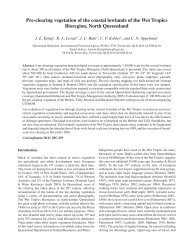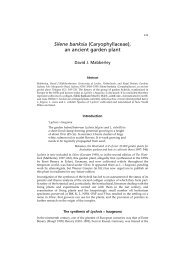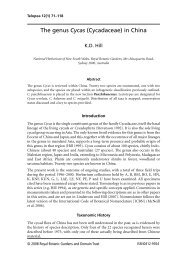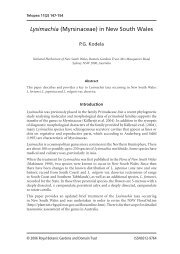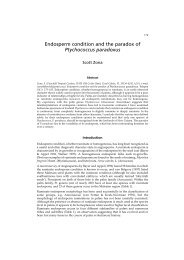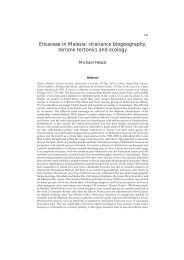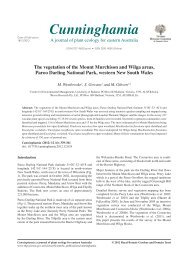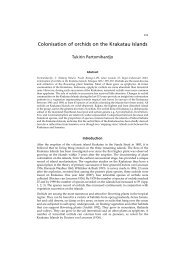Bryophytes and their distribution in the Blue Mountains region of ...
Bryophytes and their distribution in the Blue Mountains region of ...
Bryophytes and their distribution in the Blue Mountains region of ...
Create successful ePaper yourself
Turn your PDF publications into a flip-book with our unique Google optimized e-Paper software.
230 Cunn<strong>in</strong>ghamia 10(2): 2007 Down<strong>in</strong>g et al, <strong>Bryophytes</strong> <strong>in</strong> <strong>the</strong> <strong>Blue</strong> Mounta<strong>in</strong>s<br />
Methods<br />
Records <strong>of</strong> bryophytes (mosses, liverworts <strong>and</strong> hornworts)<br />
that occur <strong>in</strong> <strong>the</strong> <strong>Blue</strong> Mounta<strong>in</strong>s <strong>region</strong> <strong>of</strong> New South<br />
Wales (latitude 33˚–34˚ S, longitude 151˚–151˚40’ E) were<br />
tabulated by geographical areas based on species lists from<br />
field collections <strong>and</strong> herbarium records.<br />
Dur<strong>in</strong>g <strong>the</strong> last 25 years, <strong>the</strong> authors have made regular field<br />
trips to <strong>the</strong> <strong>Blue</strong> Mounta<strong>in</strong>s for a variety <strong>of</strong> purposes, <strong>in</strong>clud<strong>in</strong>g<br />
collect<strong>in</strong>g bryophytes for taxonomic <strong>and</strong> genetic studies, <strong>and</strong><br />
for teach<strong>in</strong>g. The result<strong>in</strong>g collections, now variously housed<br />
at <strong>the</strong> National Herbarium <strong>of</strong> New South Wales (NSW),<br />
University <strong>of</strong> Sydney (SYD) <strong>and</strong> Macquarie University,<br />
have provided <strong>the</strong> base for this work. Geographically based<br />
species lists from Ramsay, Down<strong>in</strong>g & Sch<strong>of</strong>ield (1990), <strong>and</strong><br />
Selkirk, Adamson & Down<strong>in</strong>g (2001), vouchers for which<br />
are held at Macquarie University, have been <strong>in</strong>cluded. Lists<br />
<strong>of</strong> bryophyte species collected, at each <strong>Blue</strong> Mounta<strong>in</strong>s field<br />
trip location, by participants <strong>of</strong> <strong>the</strong> Australasian Bryological<br />
Workshop held <strong>in</strong> <strong>the</strong> <strong>Blue</strong> Mounta<strong>in</strong>s <strong>in</strong> 2001 have also<br />
been <strong>in</strong>cluded.<br />
O<strong>the</strong>r records <strong>of</strong> bryophytes from <strong>the</strong> <strong>Blue</strong> Mounta<strong>in</strong>s were<br />
sought from herbaria, <strong>in</strong>clud<strong>in</strong>g <strong>the</strong> National Herbarium<br />
<strong>of</strong> New South Wales (NSW), <strong>the</strong> Down<strong>in</strong>g Herbarium at<br />
Macquarie University, <strong>the</strong> John Ray Herbarium at University<br />
<strong>of</strong> Sydney (SYD), <strong>the</strong> Australian National Herbarium<br />
(CANB) <strong>and</strong> <strong>the</strong> National Herbarium <strong>of</strong> Victoria (MEL).<br />
Previously unpublished specimen-based records <strong>in</strong>clude<br />
approximately 2000 mosses <strong>and</strong> 1000 liverwort records.<br />
Records were grouped for locations with similar geography<br />
<strong>and</strong> elevation. For example, Lapstone, Glenbrook, Blaxl<strong>and</strong><br />
<strong>and</strong> Mount Riverview have been grouped under Glenbrook;<br />
Valley Heights, Spr<strong>in</strong>gwood <strong>and</strong> Faulconbridge have been<br />
grouped under Spr<strong>in</strong>gwood. Locations range from low<br />
elevations at Glenbrook to high elevations at Blackheath <strong>and</strong><br />
Newnes Plateau, <strong>and</strong> <strong>in</strong>clude sites on a range <strong>of</strong> geological<br />
substrates <strong>in</strong>clud<strong>in</strong>g s<strong>and</strong>stone, shale <strong>and</strong> basalt.<br />
For <strong>the</strong> most part, collected material was returned to <strong>the</strong><br />
laboratory, <strong>and</strong> identified us<strong>in</strong>g published keys, such as<br />
Mosses <strong>of</strong> Sou<strong>the</strong>rn Australia (Scott & Stone 1976), Sou<strong>the</strong>rn<br />
Australian Liverworts (Scott 1985), Mosses <strong>of</strong> South Australia<br />
(Catcheside, 1980) <strong>and</strong> The Mosses <strong>of</strong> New Zeal<strong>and</strong> (Beever,<br />
Allison & Child 1992). More recently, <strong>the</strong> Key to <strong>the</strong> Genera<br />
<strong>of</strong> Australian Mosses (Buck, Vitt & Malcolm 2002) has been<br />
a valuable addition to this list. Also <strong>in</strong>valuable have been a<br />
raft <strong>of</strong> taxonomic papers published <strong>in</strong> recent years that have<br />
allowed accurate identification <strong>of</strong> particular taxa, for example:<br />
Bryaceae (Spence & Ramsay 1996, 1999), Dicranoloma<br />
(Klazenga 2003), Funariaceae (Fife & Seppelt 2001), Grimmia<br />
(Greven 2000), Hookeriaceae (Streimann 1997), Macromitrium<br />
(Vitt & Ramsay 1985), Sematophyllaceae (Ramsay, Sch<strong>of</strong>ield<br />
& Tan 2002), Sphagnum (Seppelt 2000), Papillaria (Streimann<br />
1991) <strong>and</strong> as yet unpublished taxonomic keys prepared by<br />
S. Gilmore (Ech<strong>in</strong>odiaceae <strong>and</strong> Fabroniaceae).<br />
Taxonomy <strong>and</strong> allocation to families for moss taxa follows<br />
Streimann & Klazenga (2002) with <strong>the</strong> exception <strong>of</strong> some<br />
Bryaceae taxa, for which we have referred to Spence &<br />
Ramsay (2006). Taxonomy <strong>and</strong> allocation to families for<br />
liverwort <strong>and</strong> hornwort taxa follows McCarthy (2003). New<br />
state records for mosses, liverworts <strong>and</strong> hornworts were<br />
determ<strong>in</strong>ed from <strong>the</strong> respective Catalogues. Records <strong>of</strong> moss<br />
taxa new for <strong>the</strong> Central Tablel<strong>and</strong>s Botanical Division have<br />
been determ<strong>in</strong>ed from Ramsay’s (1984) Census <strong>of</strong> New<br />
South Wales Mosses. Authorities for taxa that occur <strong>in</strong> <strong>the</strong><br />
<strong>Blue</strong> Mounta<strong>in</strong>s are <strong>in</strong>cluded <strong>in</strong> Tables 3 & 4.<br />
The follow<strong>in</strong>g notation has been used where relevant <strong>in</strong> <strong>the</strong><br />
text <strong>and</strong> <strong>in</strong> <strong>the</strong> appendices.<br />
* Indicates an <strong>in</strong>troduced species.<br />
c Indicates a cosmopolitan species.<br />
† Indicates an Australian endemic species.<br />
# Indicates a new record for New South Wales.<br />
Results<br />
We have tabulated records <strong>of</strong> 348 bryophyte taxa for <strong>the</strong><br />
<strong>Blue</strong> Mounta<strong>in</strong>s <strong>region</strong>. The moss taxa comprise 225 moss<br />
species <strong>in</strong> 108 genera <strong>and</strong> 45 families (Table 3), <strong>and</strong> <strong>in</strong>clude<br />
23 Australian endemics <strong>and</strong> eight new species records for<br />
New South Wales. The moss families with most taxa were<br />
<strong>the</strong> Pottiaceae with 23 species <strong>in</strong> 13 genera, Bryaceae with<br />
15 species <strong>in</strong> 3 genera <strong>and</strong> Fissidentaceae with 13 species<br />
<strong>of</strong> Fissidens. Calomnion complanatum, previously known<br />
<strong>in</strong> New South Wales only from Cambewarra Mounta<strong>in</strong> on<br />
<strong>the</strong> south coast, is reported from Mount Wilson <strong>and</strong> Rocky<br />
Creek on <strong>the</strong> Newnes Plateau.<br />
Liverwort taxa <strong>in</strong>clude 120 taxa <strong>in</strong> 51 genera <strong>in</strong> 24 families<br />
(Table 4), <strong>in</strong>clud<strong>in</strong>g eight species that are new records<br />
for New South Wales. There were many more species <strong>of</strong><br />
Lepidoziaceae (29 species <strong>in</strong> 10 genera) than <strong>the</strong>re were <strong>of</strong><br />
any o<strong>the</strong>r liverwort family. The rare liverwort Haplomitrium<br />
<strong>in</strong>termedium is recorded from Bowens Creek <strong>and</strong> Lawson.<br />
Elsewhere <strong>in</strong> New South Wales it is only known from<br />
Kur<strong>in</strong>g-gai Chase National Park. Enigmella thall<strong>in</strong>a was<br />
observed (but not collected) by K. Beckman at Pierces Pass<br />
near Mount Banks (K. Beckman pers. comm.). It has not<br />
been previously recorded from <strong>the</strong> <strong>Blue</strong> Mounta<strong>in</strong>s.<br />
Hornwort taxa <strong>in</strong>cluded three species from three genera <strong>in</strong><br />
one family (Table 4), add<strong>in</strong>g two species <strong>and</strong> two genera to<br />
Ramsay & Selkirk’s 1994 list<strong>in</strong>g.





